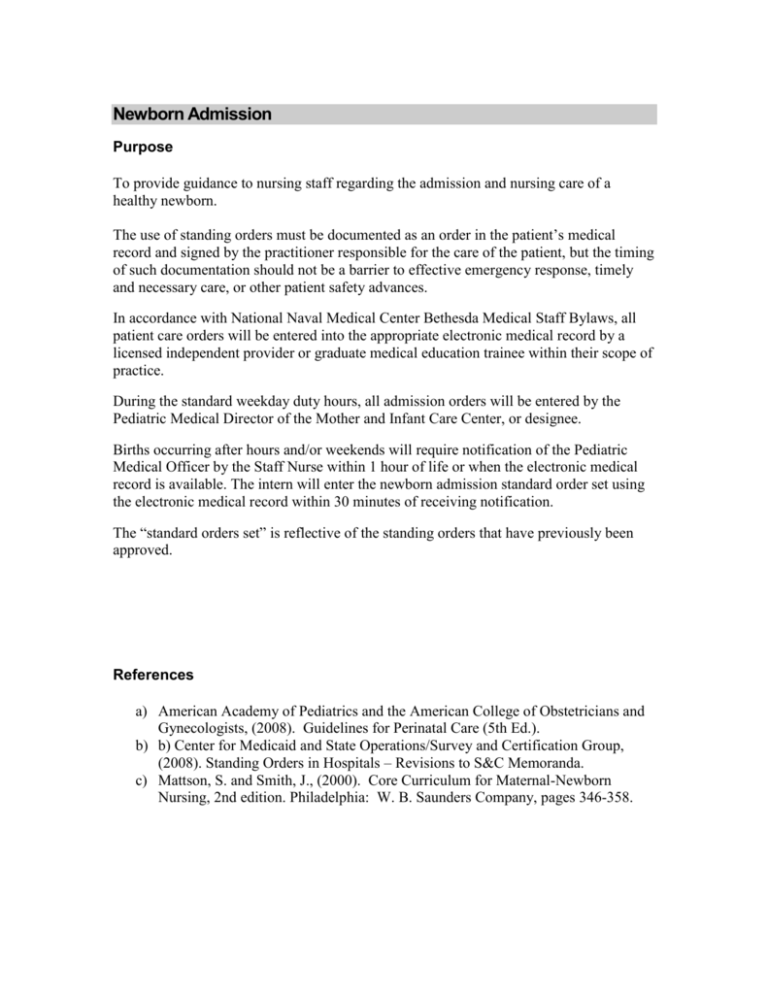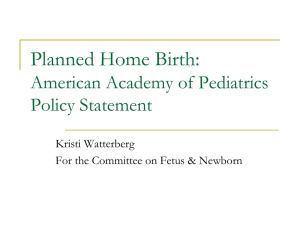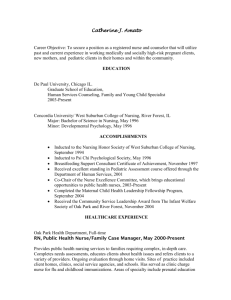MICC Newborn Order SOP
advertisement

Newborn Admission Purpose To provide guidance to nursing staff regarding the admission and nursing care of a healthy newborn. The use of standing orders must be documented as an order in the patient’s medical record and signed by the practitioner responsible for the care of the patient, but the timing of such documentation should not be a barrier to effective emergency response, timely and necessary care, or other patient safety advances. In accordance with National Naval Medical Center Bethesda Medical Staff Bylaws, all patient care orders will be entered into the appropriate electronic medical record by a licensed independent provider or graduate medical education trainee within their scope of practice. During the standard weekday duty hours, all admission orders will be entered by the Pediatric Medical Director of the Mother and Infant Care Center, or designee. Births occurring after hours and/or weekends will require notification of the Pediatric Medical Officer by the Staff Nurse within 1 hour of life or when the electronic medical record is available. The intern will enter the newborn admission standard order set using the electronic medical record within 30 minutes of receiving notification. The “standard orders set” is reflective of the standing orders that have previously been approved. References a) American Academy of Pediatrics and the American College of Obstetricians and Gynecologists, (2008). Guidelines for Perinatal Care (5th Ed.). b) b) Center for Medicaid and State Operations/Survey and Certification Group, (2008). Standing Orders in Hospitals – Revisions to S&C Memoranda. c) Mattson, S. and Smith, J., (2000). Core Curriculum for Maternal-Newborn Nursing, 2nd edition. Philadelphia: W. B. Saunders Company, pages 346-358. Infant Identification 1) All infants will be properly identified and bands will be placed immediately following birth. 2) Bands will include the following information: a. Mother’s last name, first name b. Mother’s “J” Number c. Date and time of birth d. Infant gender Note: If a “J” number is not available, use of the mother’s Family Member Prefix and Sponsor’s Social Security Number is advised. In the case of multiple births, infants will be identified in order using “A”, “B”, “C” etc. Labor and Delivery 1) The Staff Nurse will review the maternal history to identify potential concerns and/or complications. Communication regarding maternal history may be expressed to the pediatric provider and nursing staff as needed. 2) Upon delivery of the newborn, immediate resuscitation will be carried out by personnel qualified per the recommendations of the American Academy of Physicians and/or Neonatal Resuscitation Program (NRP). If pediatrics is in attendance/called to attend, or if advanced resuscitation is required (i.e. blow \by oxygen, positive pressure ventilation), the infant should be promptly moved to the warmer. 3) APGAR scores will be assigned at one and five minutes of age by a competent NRP provider, attending to and resuscitating the newborn. Scores will be recorded in the Delivery Summary and Newborn Nursing Admission. If delivery is via Cesarean Section, scores will also be placed in the Perioperative Nursing Note. 4) When the clamp is placed on the umbilical cord the number of vessels should be noted on the Delivery Summary. 5) If the infant is asymptomatic he/she will remain in the Labor Room with the mother. The infant should be kept skin-to-skin with the mother for maximum warmth after drying. The mother should be encouraged to breastfeed or bottle feed her baby per preference. 6) An observation must be done every thirty minutes x2 hours. The first observation is the apgar at 1 and 5 minutes. Starting at 30 minutes after birth observations will include: temperature, heart rate, tone, activity, level of consciousness, color, respiratory rate and effort). Document on the Newborn Nursing Admission. The assessments and documentation will be in accordance with Physician’s Orders. 7) All infants should receive Vitamin K and Erythromycin 0.5% (Ilotycin) Ophthalmic Ointment per Physician’s Orders. Document administration of medications using the Newborn Nursing Admission and Medication Administration Record (MAR). Refer to “Neonatal Medication Refusal” Standard Operating Procedure for parental refusal. 8) If the infant is placed under a radiant warmer, use SERVO mode, with skin temperature probe applied to the lower right quadrant of the abdomen, over the liver. Set radiant warmer to 36.5C. 9) The maternal history, including the Delivery Summary and Newborn Nursing Admission must be completed by the Staff Nurse prior to transfer to Couplet Care, unless the newborn condition warrants otherwise. Transition Period 1) During the transition period the newborn observations and head to toe physical assessment will be completed. Immediately notify the pediatric provider of any high-risk factors and/or any abnormal physical findings, signs or symptoms, and record the physician’s name and time notified on the newborn electronic medical record. Length, weight, and head circumference should be documented on the Newborn Nursing Admission and plotted to establish classifications. Use obstetrical B dating criteria to determine gestational age. 2) If stable, strongly recommend feeding within 1 hour of birth while the infant is alert. Infants at risk for hypoglycemia refer to “Newborn Hypoglycemia” Standard Operating Procedure. 3) A physical examination will be completed on all infants. Any abnormality will be reported to the pediatric provider. Special Consideration(s) 1) The Immunizations Clinic will administer Hepatitis B Vaccines to infants upon consent by the parent. 2) The Staff Nurse will notify the Pediatric Provider of any mother with a positive Hepatitis B Surface Antigen, positive Human Immunodeficiency Virus or unknown status. These infants will require an immediate bath prior to administration of any ordered medications. LCDR Angela Stanley NC, USN LCDR Catherine Corbett, NC USN Jeffrey Greenwald, MD 9 December 2010 9 December 2010 10 December 2010




